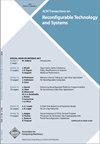基于FPGA的多异构引擎深度学习模型设计
IF 2.8
4区 计算机科学
Q2 COMPUTER SCIENCE, HARDWARE & ARCHITECTURE
引用次数: 0
摘要
深度学习模型正变得越来越复杂和异构,并增加了新的层类型以提高其准确性。这给深度神经网络加速器的设计者带来了相当大的挑战。有几种架构和设计流程可以将深度学习模型映射到硬件上,但它们仅限于特定的模型和/或层类型。此外,这些工具生成的体系结构通常针对高性能设备,不适合嵌入式计算。本文提出了在FPGA上实现深度学习模型的多引擎架构和设计流程。硬件设计采用高级综合,实现设计空间的探索。该架构是可扩展的,因此适用于任何密度的fpga。将该体系结构和设计流程应用于基于ResNet50的图像分类、基于YOLOv3-Tiny的目标检测和基于Deeplabv3+的图像分割的软硬件系统开发。该系统在低密度Zynq UltraScale+ ZU3EG FPGA上进行了测试,以显示其可扩展性。结果表明,所提出的多引擎架构产生了高效的加速器。采用4位量化的ResNet50加速器达到67 FPS,采用吞吐量为36 FPS的YOLOv3-Tiny目标检测器和图像分割应用程序达到1.4 FPS。本文章由计算机程序翻译,如有差异,请以英文原文为准。
Designing Deep Learning Models on FPGA with Multiple Heterogeneous Engines
Deep learning models are becoming more complex and heterogeneous with new layer types to improve their accuracy. This brings a considerable challenge to the designers of accelerators of deep neural networks. There have been several architectures and design flows to map deep learning models on hardware, but they are limited to a particular model and/or layer types. Also, the architectures generated by these tools target, in general, high-performance devices, not appropriate for embedded computing. This paper proposes a multi-engine architecture and a design flow to implement deep learning models on FPGA. The hardware design uses high-level synthesis to allow design space exploration. The architecture is scalable and therefore applicable to any density FPGAs. The architecture and design flow were applied to the development of a hardware/software system for image classification with ResNet50, object detection with YOLOv3-Tiny and image segmentation with Deeplabv3+. The system was tested in a low-density Zynq UltraScale+ ZU3EG FPGA to show its scalability. The results show that the proposed multi-engine architecture generates efficient accelerators. An accelerator of ResNet50 with a 4-bit quantization achieves 67 FPS, and the object detector with YOLOv3-Tiny with a throughput of 36 FPS and the image segmentation application achieves 1.4 FPS.
求助全文
通过发布文献求助,成功后即可免费获取论文全文。
去求助
来源期刊

ACM Transactions on Reconfigurable Technology and Systems
COMPUTER SCIENCE, HARDWARE & ARCHITECTURE-
CiteScore
4.90
自引率
8.70%
发文量
79
审稿时长
>12 weeks
期刊介绍:
TRETS is the top journal focusing on research in, on, and with reconfigurable systems and on their underlying technology. The scope, rationale, and coverage by other journals are often limited to particular aspects of reconfigurable technology or reconfigurable systems. TRETS is a journal that covers reconfigurability in its own right.
Topics that would be appropriate for TRETS would include all levels of reconfigurable system abstractions and all aspects of reconfigurable technology including platforms, programming environments and application successes that support these systems for computing or other applications.
-The board and systems architectures of a reconfigurable platform.
-Programming environments of reconfigurable systems, especially those designed for use with reconfigurable systems that will lead to increased programmer productivity.
-Languages and compilers for reconfigurable systems.
-Logic synthesis and related tools, as they relate to reconfigurable systems.
-Applications on which success can be demonstrated.
The underlying technology from which reconfigurable systems are developed. (Currently this technology is that of FPGAs, but research on the nature and use of follow-on technologies is appropriate for TRETS.)
In considering whether a paper is suitable for TRETS, the foremost question should be whether reconfigurability has been essential to success. Topics such as architecture, programming languages, compilers, and environments, logic synthesis, and high performance applications are all suitable if the context is appropriate. For example, an architecture for an embedded application that happens to use FPGAs is not necessarily suitable for TRETS, but an architecture using FPGAs for which the reconfigurability of the FPGAs is an inherent part of the specifications (perhaps due to a need for re-use on multiple applications) would be appropriate for TRETS.
 求助内容:
求助内容: 应助结果提醒方式:
应助结果提醒方式:


